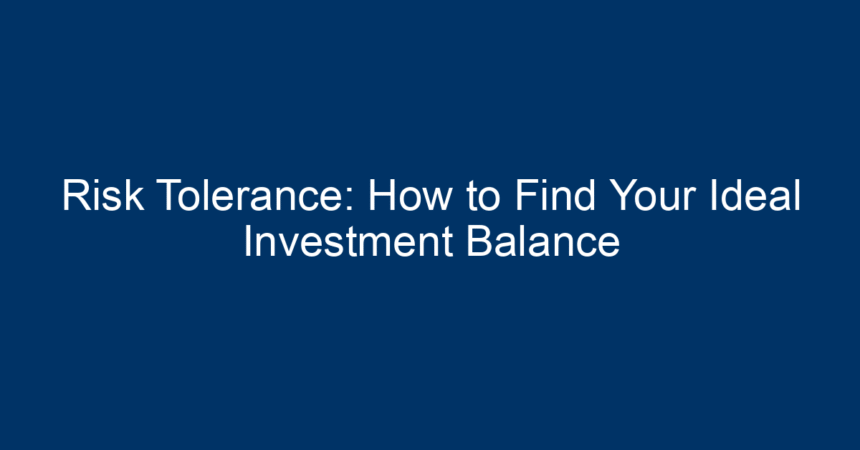Investing can be a daunting experience, especially when faced with the uncertainty of market fluctuations. But understanding your risk tolerance—the degree of variability in investment returns you can withstand—can empower you to make informed financial decisions. In this comprehensive guide, we’ll explore the concept of risk tolerance, how to assess it, and tips for finding your ideal investment balance. By the end of this article, you’ll be armed with the knowledge to navigate the investment landscape with confidence.
What is Risk Tolerance?
Risk tolerance is an essential concept in personal finance and investing. It reflects your emotional and psychological capacity to handle the ups and downs of market performance. Generally, risk tolerance can be classified into three main categories:
- Conservative: Individuals who prefer minimal risk and prioritize preserving capital over seeking high returns.
- Moderate: Investors who are open to taking on some risk for potentially higher returns, balancing growth and safety.
- Aggressive: Those who are willing to take significant risks in the pursuit of substantial returns, often focusing on high-risk investments.
Your risk tolerance is influenced by various factors, including age, financial goals, investment experience, and personal temperament.
Why is Risk Tolerance Important?
Understanding your risk tolerance is crucial for several reasons:
1. Tailored Investment Strategy
By knowing your risk tolerance, you can create an investment strategy that aligns with your comfort level. This ensures that you won’t panic during market downturns, leading to hasty and potentially detrimental decisions.
2. Long-term Success
Investing is typically a long-term endeavor. A portfolio that reflects your risk tolerance can help you stay committed to your investment strategy, even in volatile markets. This discipline is key to achieving long-term financial goals.
3. Financial Security
A well-balanced approach takes into consideration not just potential returns but also your financial security. Understanding how much risk you can handle can safeguard your savings and help you avoid unnecessary stress.
Assessing Your Risk Tolerance
Determining your risk tolerance is a vital first step in the investment process. Here are some effective ways to assess it:
1. Self-Assessment Questionnaires
Many financial institutions and websites offer self-assessment questionnaires. These typically ask about your investment experience, the time horizon for your financial goals, your emotional reaction to market fluctuations, and your overall financial situation. Answering these questions can provide a clear picture of your risk tolerance.
2. Reflect on Your Financial Goals
Consider your short-term and long-term financial objectives. If you’re saving for a short-term goal (like a home purchase in two years), a conservative approach may be appropriate. Conversely, if you’re investing for retirement decades away, you might be able to take on more risk for higher potential returns.
3. Evaluate Your Financial Situation
Your current financial situation plays a significant role in determining risk tolerance. Factors include income, savings, debt, and emergency fund availability. The more secure your financial position, the higher risk you might be willing to accept.
4. Understand Your Emotional Capacity
Every investor reacts differently to market changes. Ask yourself how you feel about losing money in the short term. If you find it difficult to cope with losses, a conservative investment strategy may be more suitable.
Factors That Influence Risk Tolerance
Several factors can influence your risk tolerance beyond just personal experience and emotional capacity. Let’s delve into these:
1. Age
As a general rule, younger investors can afford to take on more risk because they have time to recover from market downturns. Conversely, older investors nearing retirement often prefer safer investments to protect their accumulated savings.
2. Investment Knowledge
The more you know about investing and market behavior, the more comfortable you may feel taking on risk. Continuous education—through books, courses, or workshops—can enhance your confidence and willingness to engage with various investment avenues.
3. Economic Environment
The broader economic landscape can also influence perceptions of risk. During uncertain times, such as recessions, even seasoned investors may become more conservative. Understanding the macroeconomic factors at play can help you make informed decisions.
4. Individual Circumstances
Life events such as marriage, children, or unexpected job loss can shift your financial priorities and risk tolerance. Regularly reassessing your situation and adjusting your strategies accordingly is essential.
Building Your Investment Portfolio Based on Risk Tolerance
Once you have an understanding of your risk tolerance, it’s time to build your investment portfolio. Here are some strategies to consider:
1. Diversification
Diversification involves spreading your investments across various asset classes (stocks, bonds, real estate) to minimize risk. A balanced portfolio reduces the impact of poor performance from any one investment.
2. Asset Allocation
Your asset allocation should align with your risk tolerance. For example:
- Conservative: 20% stocks, 70% bonds, 10% cash
- Moderate: 60% stocks, 30% bonds, 10% cash
- Aggressive: 80% stocks, 15% bonds, 5% alternative investments
3. Regular Rebalancing
As markets fluctuate, your asset allocation can drift away from its initial design. Regularly rebalancing your portfolio ensures it remains aligned with your risk tolerance and investment goals.
4. Professional Advice
If you’re unsure about your risk tolerance or how to create a balanced portfolio, consider seeking advice from a financial advisor. They can provide personalized guidance based on your specific circumstances.
Managing Risk Tolerance Over Time
Your risk tolerance isn’t static—it evolves with changes in your life and financial situation. Here are tips for managing it effectively:
1. Regular Reviews
Set aside time to review your investment strategy and risk tolerance on an annual basis or during major life changes. This ensures your investments continue to align with your goals.
2. Stay Educated
Continuous learning about investment strategies and market trends can enhance your confidence and, in turn, impact your risk tolerance.
3. Stay Emotionally Grounded
Recognize the emotional aspects of investing. Staying calm during market volatility requires discipline, so develop a plan and stick with it rather than making impulsive decisions based on fear or euphoria.
Conclusion: Taking Action on Your Risk Tolerance
Finding your ideal investment balance through understanding your risk tolerance is a journey, not a destination. By assessing your risk, creating a tailored investment strategy, and managing it over time, you can navigate the complexities of investing with confidence.
Remember, the key to successful investing lies not just in seeking high returns but in aligning your investments with your unique financial goals and comfort levels. Start by taking a risk tolerance assessment today, and watch how your financial future unfolds with clarity and assurance. By practicing patience and discipline, while regularly reframing your perspective on risk, you’ll be well on your way to achieving your financial aspirations.
By following these actionable insights on risk tolerance, you can master your investment journey, ensuring both growth and security as you work towards your financial dreams. Whether you choose to be conservative, moderate, or aggressive, remember that the best investment strategy is one that feels right for you.




